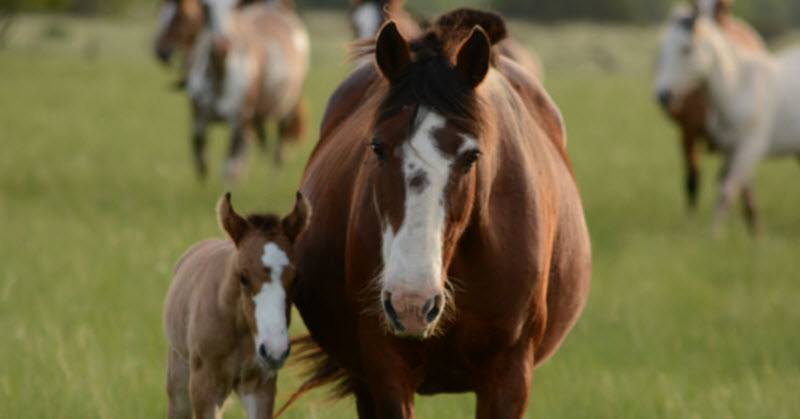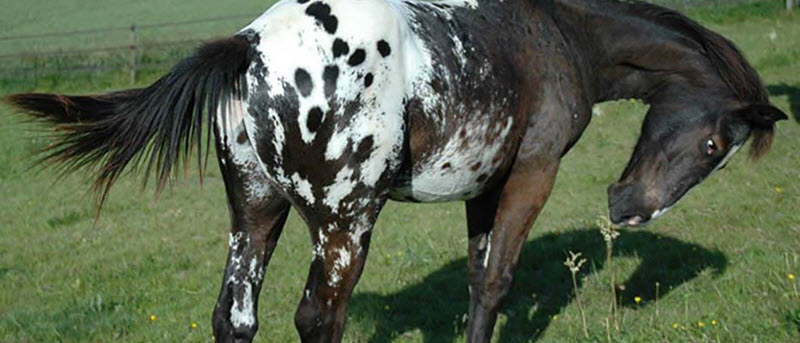Contents
This horse breed is named after the U.S. state of Colorado. It developed on the Colorado High Plains and is ideal for working with cattle on the high plain ranches.
The Colorado Ranger is still a common sight on the Colorado High Plains, and their well-earned reputation for understanding cattle has also made them sought after among ranchers in the Midwest and Eastern United States.
In addition to working with cattle, Colorado Rangers are (unsurprisingly) a great choice for Western riding and competitions. They also work well for trail riding.

What does a Colorado Ranger look like?
The Colorado Ranger is a deep-chested horse with a short back. Shoulders and croup are sloping. The neck is long and muscular, and the head sports a straight facial profile.
The standard height is 14.2 – 16 hands.
Any solid colour is permitted, and leopard spotting is also allowed. Pinto colouration and American Paint Horse colouration are not permitted.
The history of the Colorado Ranger
Leopard and Linden Tree
All members of this horse breed can trace their ancestry back to one or both of two stallions given by the Turkish Sultan Abdul Hamid II to the U.S. President Ulysses S. Grant in 1878. These stallions – Linden Tree and Leopard – were eventually bred to many ranch mares in Colorado and nearby Nebraska.
Leopard was a desert-bred Arabian (Arab) horse foaled in 1873. Linden Tree was a grey Berber (Barb) horse foaled in 1874. Less well-known than the Arab, the Berber horse breed is native to north Africa and renowned for its stamina, hardiness and fiery temperament.
When Leopard and Linden Tree first came to the United States, they stayed in Virginia for quite a few years where they lived with breeding herds owned by Randolph Huntington. In 1896, Ulysses S. Grant´s friend General Colby was allowed to lease both stallions and breed them with mares on his ranch in Nebraska.
The horses sired by Leopard and Linden Tree in Nebraska turned out to be excellent ranch horses, and General Colby´s neighbours didn´t fail to notice this. Eventually, their reputation reached all the way to Colorado, where a group of ranchers pooled together and purchased several such ranch horses from the general – one few-spot leopard Appaloosa stallion and several mares. The stallion was a grandson of Leopard on both sides, while all the mares had been sired directly by either Leopard or Linden Tree.
Back in Colorado, the group of ranchers used their new horses to improve their own ranch stock – the birth of the Colorado Ranger horse breed.
Spotte
In the early 20th century, Linden Trees Berber horse DNA had become rather diluted in the Colorado Ranger breed, but in 1918 the owner of the W.R. Thompson Cattle Company decided to import a new Berber horse directly from North Africa as a present for his daughter who was getting married. This imported horse – named Spotte – gave the Colorado Ranger breed a new strong infusion of Berber DNA, as mating your Colorado Range with Spotte, or any of his direct offspring became very common.
The horseman Mike Ruby
A very important person in the 20th-century history of the Colorado Ranger is the horseman Mike Ruby who lived on the Colorado High Plains. During the devastating Dust Bowl draughts and sandstorms of the 1930s, Ruby saved the lives of many Colorado Ranger horses by driving them 300+ miles to get them to a place where there was still sufficient pasture. When the drought finally ended, Ruby commenced another drive to get Colorado Ranger horses back to the high plains again.
After the horrors of the Dust Bowl, Ruby managed to re-establish his own breeding herd and also began promoting the Colorado Ranger breed by leasing horses to other ranchers who used them for breeding.
Ruby kept detailed records and we know from these records that the Colorado Ranger breed received genetic input from several western stock horse breeds, such as Quarterhorse and Appaloosa.
Ruby is also famous for founding the Colorado Ranger Horse Association (CRHA) and for being the owner of the extremely important foundation stallions Patches #1 and Max #2.

The Colorado Ranger Horse Association
The Colorado Ranger Horse Association (CRHA) was founded by Mike Ruby in 1935, and he used his own horse breeding records as the initial pedigree record for the Colorado Ranger breed.
The original bylaws stipulated that a maximum of 50 members would be permitted to register their horses with the organization, but this limit was later removed. Before the rules were changed in 1964, many Colorado Ranger horses ended up being registered as Appaloosas instead, since they didn´t belong to any of the 50 permitted members. Dual registration is still very common, and about 90% of the Colorado Rangers registered with the CRHA are also registered with the Appaloosa Horse Club.
Breeding Colorado Rangers
A foal doesn´t necessarily need to have two registered Colorado Ranger parents to be registered as a Colorado Ranger. That´s because a registered Colorado Ranger can be bred to any of five specific approved horse breeds and produce offspring that will be eligible for registration with the CRHA (provided that standard conditions are fulfilled).
These are the five approved breeds:
- Appaloosa
- Ara Appaloosa
- Arabian
- Thoroughbred
- American Quarterhorse
Lusitano?
In the 1980s, the Lusitano was on the list of approved breeds. This is a Portuguese breed, a fairly close relative of the more well-known Andalusian horse. The Lusitano is no longer on the approved-breeds list.
No drafts, no ponies, no Pinto, no Paint
A horse with draft horse or pony blood can not be registered with the CRHA. There is also a ban against registering any horse that has Pinto or American Paint Horse breeding within five generations of the individual´s pedigree.
